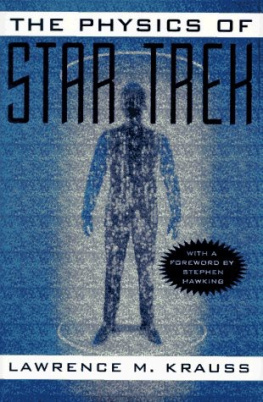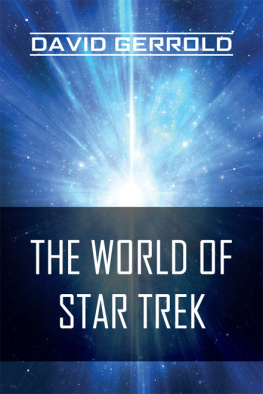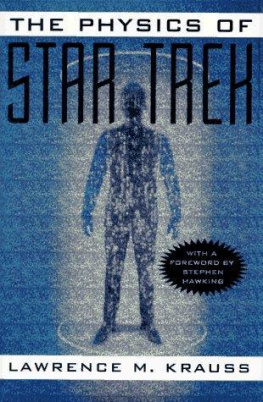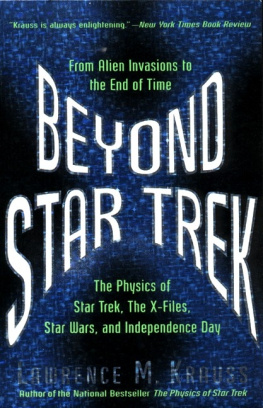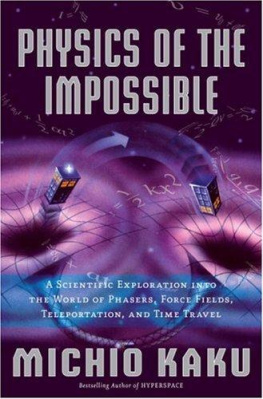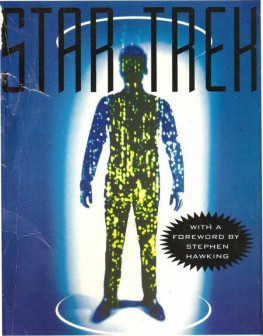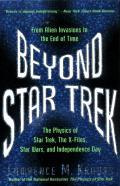FOREWORD
Stephen Hawking
I was very pleased that Data decided to call Newton, Einstein, and me for a game of poker aboard the Enterprise. Here was my chance to turn the tables on the two great men of gravity, particularly Einstein, who didn't believe in chance or in God playing dice. Unfortunately, I never collected my winnings because the game had to be abandoned on account of a red alert. I contacted Paramount studios afterward to cash in my chips, but they didn't know the exchange rate.
Science fiction like Star Trek is not only good fun but it also serves a serious purpose, that of expanding the
human imagination. We may not yet be able to boldly go where no man (or woman) has gone before, but at least we can do it in the mind. We can explore how the human spirit might respond to future developments in science and we can speculate on what those developments might be. There is a two-way trade between science fiction and science. Science fiction suggests ideas that scientists incorporate into their theories, but sometimes science turns up notions that are stranger than any science fiction. Black holes are an example, greatly assisted by the inspired name that the physicist John Archibald Wheeler gave them. Had they continued with their original names of frozen stars or gravitationally completely collapsed objects, there wouldn't have been half so much written about them.
One thing that Star Trek and other science fiction have focused attention on is travel faster than light. Indeed, it is absolutely essential to Star Trek's story line. If the Enterprise were restricted to flying just under the speed of light, it might seem to the crew that the round trip to the center of the galaxy took only a few years, but 80,000 years would have elapsed on Earth before the spaceship's return. So much for going back to see your family!
Fortunately, Einstein's general theory of relativity allows the possibility for a way around this difficulty: one might be able to warp spacetime and create a shortcut between the places one wanted to visit. Although there are problems of negative energy, it seems that such warping might be within our capabilities in the future. There has not been much serious scientific research along these lines, however, partly, I think, because it sounds too much like science fiction. One of the consequences of rapid interstellar travel would be that one could also travel back in time. Imagine the outcry about the waste of taxpayers' money if it were known that the National Science Foundation were supporting research on time travel. For this reason, scientists working in this field have to disguise their real interest by using technical terms like closed timelike curves that are code for time travel. Nevertheless, today's science fiction is often tomorrow's science fact. The physics that underlies Star Trek is surely worth investigating. To confine our attention to terrestrial matters would be to limit the human spirit.
PREFACE
Why the physics of Star Trek? Gene Roddenberry's creation is, after all, science fiction, not science fact. Many of the technical wonders in the series therefore inevitably rest on notions that may be ill defined or otherwise at odds with our current understanding of the universe. I did not want to write a book that ended up merely outlining where the Star Trek writers went wrong.
Yet I found that I could not get the idea of this book out of my head. I confess that it was really the transporter that seduced me. Thinking about the challenges that would have to be faced in devising such a fictional technology forces one to ponder topics ranging from computers and the information superhighway to particle physics, quantum mechanics, nuclear energy, telescope building, biological complexity, and even the possible existence of the human soul! Compound this with ideas such as warped space and time travel and the whole subject became irresistible.
I soon realized that what made this so fascinating to me was akin to what keeps drawing fans to Star Trek today, almost thirty years after the series first aired. This is, as the omnipotent Star Trek prankster Q put it, charting the unknown possibilities of existence. And, as I am sure Q would have agreed, it is even good fun to imagine them.
As Stephen Hawking states in the foreword to this book, science fiction like Star Trek helps expand the human imagination. Indeed, exploring the infinite possibilities the future holdsincluding a world where humanity has overcome its myopic international and racial tensions and ventured out to explore the universe in peaceis part of the continuing wonder of Star Trek. And, as I see this as central to the continuing wonder of modern physics, it is these possibilities that I have chosen to concentrate on here.
Based on an informal survey I carried out while walking around my university campus the other day, the number of people in the United States who would not recognize the phrase Beam me up, Scotty is roughly comparable to the number of people who have never heard of ketchup. When we consider that the Smithsonian Institution's exhibition on the starship Enterprise was the most popular display in their Air and Space Museummore popular than the real spacecraft thereI think it is clear that Star Trek is a natural vehicle for many people's curiosity
about the universe. What better context to introduce some of the more remarkable ideas at the forefront of today's physics and the threshold of tomorrow's? I hope you find the ride as enjoyable as I have.
Live long and prosper.
THE PHYSICS OF STAR TREK
The Physics of Star Trek
SECTION ONE
A Cosmic Poker Game
In which the physics of inertial dampers and tractor beams paves the way for time travel, warp speed, deflector shields, wormholes, and other spacetime oddities
The Physics of Star Trek
CHAPTER ONE
NEWTON Antes
No matter where you go, there you are. From a plaque on the starship Excelsior, in Star Trek VI: The Undiscovered Country, presumably borrowed from The Adventures of Buckaroo Banzai
You are at the helm of the starship Defiant (NCC-1764), currently in orbit around the planet Iconia, near the Neutral Zone. Your mission: to rendezvous with a nearby supply vessel at the other end of this solar system in order to pick up components to repair faulty transporter primary energizing coils. There is no need to achieve warp speeds; you direct the impulse drive to be set at full power for leisurely half-light-speed travel, which should bring you to your destination in a few hours, giving you time to bring the captain's log up to date. However, as you begin to pull out of orbit, you feel an intense pressure in your chest. Your hands are leaden, and you are glued to your seat. Your mouth is fixed in an evil-looking grimace, your eyes feel like they are about to burst out of their sockets, and the blood flowing through your body refuses to rise to your head. Slowly, you lose consciousness ... and within minutes you die.
What happened? It is not the first signs of spatial interphase drift, which will later overwhelm the ship, or an attack from a previously cloaked Romulan vessel. Rather, you have fallen prey to something far more powerful. The ingenious writers of Star Trek, on whom you depend, have not yet invented inertial dampers, which they will introduce sometime later in the series. You have been defeated by nothing more exotic than Isaac Newton's laws of motionthe very first things one can forget about high school physics.
OK, I know some trekkers out there are saying to themselves, How lame! Don't give me Newton. Tell me things I really want to know, like 'How does warp drive work?' or 'What is the flash before going to warp speedis it like a sonic boom?' or 'What is a dilithium crystal anyway?' All I can say is that we will get there eventually. Travel in the Star Trek universe involves some of the most exotic concepts in physics. But many different aspects come together before we can really address everyone's most fundamental question about Star Trek: Is any of this really possible, and if so, how?

